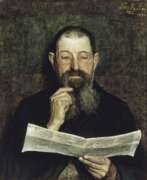Genre painters Luminism


Aloïs De Laet was a Belgian painter. As a painter, Alois De Laet was a self-taught artist who, however, learned a lot from his two uncles who were decorative painters. In 1900 he was the first to exhibit in the Cornelis Landschotkapel with the social philosophical movement 'De Kapel'. De Laet called himself one of the first Antwerp socialist artists. He painted portraits, genre scenes and landscapes with a melancholy atmosphere. Under the influence of luminism, his color palette became brighter over the years. He was a member of several art circles, including Eenigen, Als ik Kan, de Scalden, La Libre Esthétique and Vie et Lumière.


Gustave Franciscus De Smet was a Belgian painter. Together with Constant Permeke and Frits Van den Berghe, he was one of the founders of Flemish Expressionism. In 1908, he and his wife followed Léon to the artists' colony in Sint-Martens-Latem. There, they initially came under the influence of Luminism and the painter Emile Claus, who lived in nearby Astene. At the beginning of World War I, he and his family joined his friend, Van den Berghe, and fled to the Netherlands. From 1914 to 1922, they moved about, visiting and staying at the art colonies in Amsterdam, Laren and Blaricum.[2] His meeting with the Expressionist painter Henri Le Fauconnier marked a turning point in his style which, up until then, owed much to Cubism. In 1927, he settled in Deurle. It was there that his mixture of Expressionism and Cubism peaked, with a series of works depicting circus, fairground and village scenes. After his death in Deurle at the age of sixty-six, his house was preserved as a local museum.


Alfred Hazledine was a Belgian painter and graphic artist. Hazledine was a student of Ernest Blanc-Garin in Brussels and of Adrien-Joseph Heymans. He lived and worked for a long time in Wechelderzande, where there was a true artists' colony. He mainly painted landscapes in Impressionist style. Hazledine was a member of the Vie et Lumière group that brought together Impressionists and Luminists for exhibitions, and was also a member of L'Estampe and of the National Confederation of Painters and Sculptors of Belgium.


Jeanne (Jenny) Montigny was a Belgian painter. At seventeen, she decided to become an artist, knowing that she could not count on her parents' support. After seeing a painting by Emile Claus (The Kingfishers), Montigny decided to seek out a position in his studios near Deinze. In the summer of 1893, she and several other female students took his course in plein air painting. In 1902, she made her debut at the Ghent Salon, followed by shows in Paris. She later became a member of the luminist group Vie et Lumière. At the outbreak of World War I, she followed Claus and his wife in emigrating to London, where she became a member of the Women's International Art Club and exhibited at the Grafton Galleries. After the war, she returned to Belgium. In 1923, she joined the Société Nationale des Beaux-Arts.


Frans Mortelmans was a Belgian painter, draughtsman and engraver. He initially produced portraits, history paintings, marines and genre scenes. From 1892 onwards, he almost exclusively painted very decorative and harmoniously composed still lifes and flower pieces. It is through these works that he established his reputation. His compositions with pink roses are in particular highly valued. His work situates itself between impressionism and realism with some luminist touches. He produced many pastel works. Frans Mortelmans was a very prolific painter. To date, more than 850 of his works have been inventoried.





